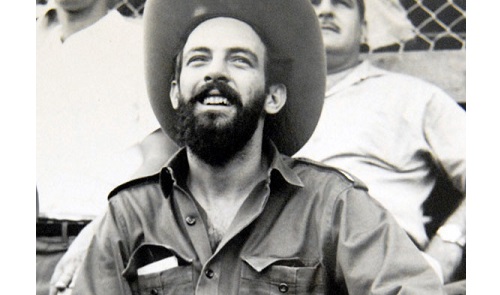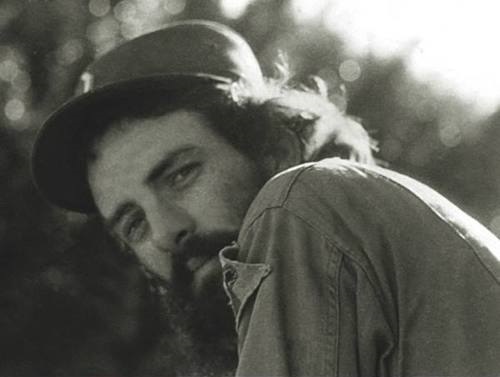|
~ Ernesto Che Guevara
~ Galéria
~ Oldal
~ Bejelentkezés
~ Vissza a Főoldalra
Ernesto Che Guevara, az argentin származású forradalmár, miniszter, gerillavezér és író, Buenos Aires-ben szerzett orvosi diplomát, majd a kubai forradalom során jelentős szerepet játszott a szigetország felszabadításában és újjáépítésében. A kubai gazdaság talpraállításáért dolgozott, küzdött az oktatás és az egészségügy fejlesztéséért, az írástudatlanság és a faji előítéletek felszámolásáért. Saját példájával népszerűsítette az önkéntes munkát. Kongóban és Bolíviában is harcolt - harminckilenc éves volt, amikor az amerikai-bolíviai csapatok csapdába ejtették és kivégezték.
| | |
|

| | |
|
|
|
Camilo Cienfuegos
|
|
|
Camilo Cienfuegos, Beloved Revolutionary Leader:
Camilo Cienfuegos (1932-1959) was a leading figure of the Cuban Revolution, along with Fidel Castro and Ché Guevara. He was one of a handful of survivors of the Granma landing in 1956 and soon distinguished himself as a leader. He defeated Batista forces at the Battle of Yaguajay in December of 1958. After the triumph of the Revolution in early 1959, Cienfuegos took on a position of authority in the army. He disappeared during a night-time flight in October, 1959 and is presumed to have died. He is considered one of the greatest heroes of the Revolution and every year, Cuba marks the anniversary of his death.
Camilo Cienfuegos: Early Years:
Young Camilo was artistically inclined: he even attended art school, but was forced to drop out when he could no longer afford it. He went to the United States for a time in the early 1950’s in search of work, but returned disillusioned. As a teenager, he became involved in protests of government policies, and as the situation in Cuba worsened, he became more and more involved in the struggle against president Fulgencio Batista. In 1955, he was shot in the leg by Batista soldiers. According to Cienfuegos, that was the moment in which he decided that he would strive to free Cuba from the Batista dictatorship.
Camilo Joins the Revolution:
Camilo went from Cuba to New York, and from there to Mexico, where he met up with Fidel Castro, who was putting together an expedition to head back to Cuba and start a revolution. Camilo eagerly joined up and was one of 82 rebels packed into the 12-passenger yacht Granma, which left Mexico on November 25, 1956, arriving in Cuba a week later. The army discovered the rebels and killed most of them but the survivors were able to hide and later regroup in the mountains.
Comandante Camilo:
As one of the survivors of the Granma group, Camilo had a certain prestige with Fidel Castro that the others who joined the revolution later did not. By the middle of 1957 he had been promoted to Comandante and had his own command. In 1958, the tide began to turn in favor of the rebels, and he was ordered to lead one of three columns to attack the city of Santa Clara: another was commanded by Ché Guevara. One squad was ambushed and wiped out, but Ché and Camilo converged on Santa Clara.
Camilo Cienfuegos and The Battle of Yaguajay:
Camilo’s force, which had been swelled by local farmers and peasants, reached the small army garrison at Yaguajay in December of 1958 and besieged it. There were about 250 soldiers inside, under the command of Cuban-Chinese captain Abon Ly. Camilo attacked the garrison but was repeatedly driven back. He even tried putting together a makeshift tank out of a tractor and some iron plates, but that didn’t work either. Eventually, the garrison ran out of food and ammunition and surrendered on December 30. The next day, the revolutionaries captured Santa Clara.
After the Revolution :
The loss of Santa Clara and other cities convinced Batista to flee the country, and the revolution was over. The handsome, affable Camilo was very popular, and upon the success of the revolution was probably the third most powerful man in Cuba, after Fidel and Raúl Castro. He was promoted to head of the Cuban armed forces in early 1959.
Arrest of Matos and Disappearance:
In October, 1959, Fidel began to suspect that Huber Matos, another one of the original revolutionaries, was plotting against him. He sent Camilo to arrest Matos, as the two were good friends. According to later interviews with Matos, Camilo was reluctant to carry out the arrest, but followed his orders and did so. Matos was sentenced and served twenty years in prison. On the night of October 28, Camilo flew back from Camaguey to Havana after completing the arrest. His plane disappeared and no trace of Camilo or the airplane was ever found. After a few frantic days of searching, the hunt was called off.
Doubts About Camilo’s Death and His Place in Cuba Today:
Camilo’s disappearance and presumed death have caused many to wonder if Fidel or Raúl Castro had him killed. There is some compelling evidence either way.
The case against: Camilo was very loyal to Fidel, even arresting his good friend Huber Matos when the evidence against him was weak. He had never given the Castro brothers any cause to doubt his loyalty or competence. He had risked his life many times for the Revolution. Ché Guevara, who was so close to Camilo that he named his son after him, denied that the Castro brothers had anything to do with Camilo’s death.
The case for: Camilo was the only Revolutionary figure whose popularity rivaled Fidel’s, and as such was one of a very few people who could go against him if he wished. Camilo’s dedication to communism was suspect: for him, the Revolution was about removing Batista. Also, he had recently been replaced as head of the army by Raúl Castro, a sign that perhaps they were going to move on him.
It will probably never be known for sure what happened to Camilo: if the Castro brothers ordered him killed, they’ll never admit it. Today, Camilo is considered one of the great heroes of the Revolution: he has his own monument at the site of the Yaguajay battlefield. Every year on October 28, Cuban schoolchildren throw flowers into the ocean for him.
Source
|
|
|


| 2014.04.23. 07:49, Aleida |
Feliz cumpleaños, Camilo!
|

Február 6. Camilo Cienfuegos, a kubai forradalom egyik legnagyobb és legnépszerűbb hőse, ma lenne 82 éves... boldog születésnapot, Camilo!
|
|
6 February. Camilo Cienfuegos, one of the biggest and the most popular heroes of the Cuban Revolutionary War, would be 82 years old today... happy birthday, Camilo!
|
|
|
| 2014.02.06. 00:00, Aleida |
Camilo-ra emlékezve...
|

Ötvennégy évvel ezelőtt ezen a napon, 1959. október 28-án Camilo Cienfuegos, a kubai forradalom egyik vezéralakja, egy repülőgép-balesetben eltűnt az Atlanti-óceán felett. Sem az ő, sem a gép maradványait nem találták meg, noha komoly kutatás folyt.
Minden év október 28-án a kubai iskolásgyerekek virágokat dobálnak a tengerbe (vagy a folyóba, ha a sziget belsejében élnek), így emlékeznek a nagyszerű, bátor harcosra.
|
|
Fifty-four years ago on this day, on 28th October 1959 Camilo Cienfuegos, one of the leaders of the Cuban Revolution, disappeared in a plane crash over the Atlantic Ocean. Neither his body, nor the remains of the aeroplane have ever been found, though a serious searching was made.
Every year on 28th October all the Cuban school children throw flowers into the sea (or into a river if they live inland) to honor and remember this amazing, brave fighter.
|
|
|
| 2013.10.28. 18:29, Aleida |
| | |
|
|
|
~ Ernesto Che Guevara
~ Gallery
~ Site
~ Log in
~ Back to the Main page
Ernesto Che Guevara, the Argentine-born revolutionary, minister, guerrilla leader and writer, received his medical degree in Buenos Aires, then played an essential part in the Cuban Revolution in liberating and rebuilding the country. He did his best to set up the Cuban economy, fought for the improvement of the education and the health system, the elimination of illiteracy and racial prejudice. He promoted voluntary work by his own example. He fought in the Congo and in Bolivia - he was thirty-nine years old, when he was trapped and executed by the joint American-Bolivian forces.
| | |
|
|

